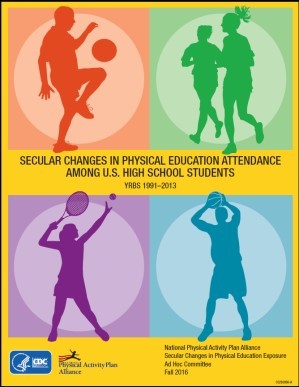
Status of Physical Education in the United States
The Community Guide strongly recommends school-based physical education as a strategy to promote physical activity among youth. Unfortunately, several claims regarding the decline in physical education exposure among U.S. students have been made in the past decade. However, few large-scale studies have examined such changes.
At the request of the President’s Council on Fitness, Sport, and Nutrition, the National Physical Activity Plan Alliance (NPAPA) was tasked with reviewing the available evidence regarding changes in exposure to school-based physical education among U.S. students. The primary objective of this effort was to better understand physical education exposure over time to inform national recommendations and strategies for physical education.
Specifically, the NPAPA was charged with:
- identifying the best existing surveys or studies with measures of physical education exposure,
- identifying and developing measures from these existing surveys or studies to assess physical education exposure over time, and
- drawing conclusions based on the best available evidence.
Physical Education Resources from the NPAPA
Three resources were developed to present the findings of this work:
1. Report: Secular Changes in Physical Education Attendance Among U.S. High School Students, YRBS 1991-2013
The purpose of the Secular Changes in Physical Education Attendance Among U.S. High School Students, YRBS 1991-2013 report was to examine secular changes in physical education attendance among U.S. high school students over the past two decades.
Key findings:
- One-half of US high school students do not attend physical education classes — which is consistent over the 22-year period studied.
- Daily physical education attendance dropped 16.2% in four years (from 41.6% in 1991 to 25.4% in 1995) — attendance rates have stabilized since then.
- Attendance in physical education classes decreases steadily as a student moves from 9th to 12th grade.
- Consistently, more boys than girls reported attending physical education over the 22-year period studied.
- The report concludes that policies and programs should be adopted that prioritize physical education in order to maximize its benefits.
2. Manuscript: Secular Changes in Physical Education Attendance Among U.S. High School Students, 1991-2015
The purpose of this study was to examine changes in school-based physical education (PE) attendance over time among nationally representative samples of U.S. high school students and how changes in PE attendance have varied across demographic subgroups. Student demographic information and PE attendance data were obtained from 13 biennial cycles (1991–2015) of the national Youth Risk Behavior Survey.
The findings revealed that there was no significant change in the percentage of students reporting PE attendance during 1991 to 2015. However, daily PE and average PE days/week declined significantly from 1991 to 1995 and then remained stable through 2015. Trends across demographic subgroups revealed notable differences in PE attendance.
In conclusion, the study findings showed that U.S. schools have not substantially reduced PE amounts in recent years. Still, the prevalence of PE attendance among U.S. high school students is well below recommendations. For PE to contribute to increased adolescent compliance with national physical activity guidelines, significant policy actions are needed to improve PE access for all students.
[Read the Full Manuscript]
3. Manuscript: Physical Education Policies in US Schools: Differences by School Characteristics
The purpose of this study was to assess the extent to which schools in the United States are implementing physical education policies identified in SHAPE America’s Essential Components of Physical Education document. Further, we examined how implementation of these policies varied by school characteristics. Data from the 2014 School Health Policies and Practices Study was used to examine school policies.
Overall, the findings revealed that the average number of physical education policies implemented by schools was 3.0. Five of the physical education policies varied by region and three varied by school level. The number of policies varied by metropolitan status and school level. Many schools were found to be implementing only a few of the physical education policies that can strengthen their physical education programs.
[Read the Full Manuscript]


